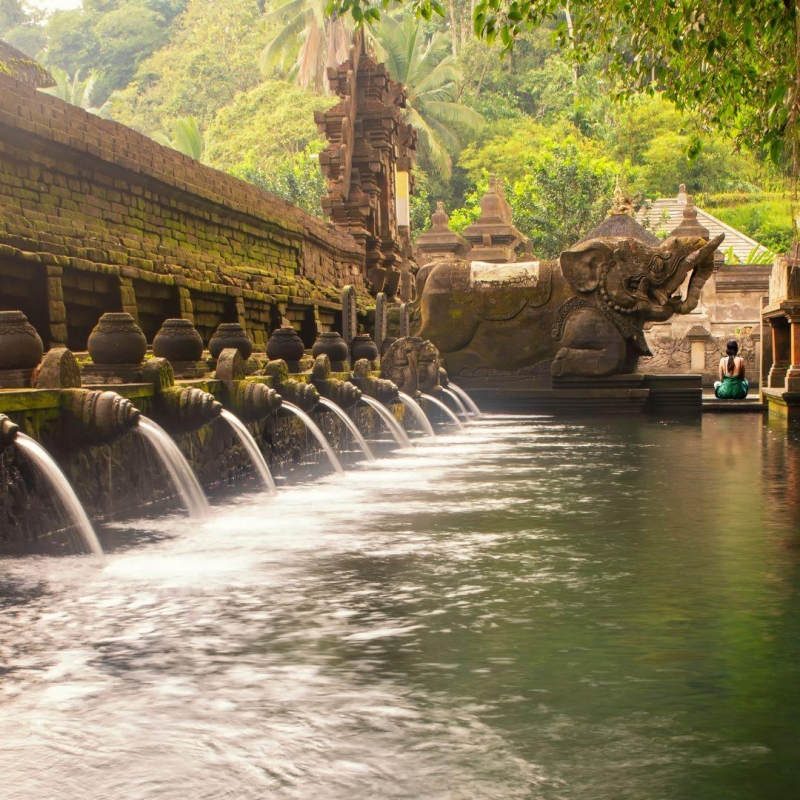Exploring Bali's Rich Historical and Archaeological Wonders. Unraveling Centuries of Legacy

Nestled amidst the verdant landscapes and pristine beaches of Bali lies a treasure trove of historical and archaeological wonders, inviting travelers on a journey through time. Beyond its renowned cultural allure and natural beauty, Bali boasts a rich tapestry of ancient sites that rival the significance of Indonesia's most celebrated landmarks like Borobudur and Prambanan temple. For history enthusiasts, these destinations offer a captivating glimpse into the island's storied past, spanning centuries of civilization and spiritual heritage.
Tukad Cepung Waterfall
Tucked away in a lush jungle canyon, Tukad Cepung Waterfall is a testament to Bali's natural marvels and cultural mystique. Accessed through a scenic trek, visitors are rewarded with the sight of sunlight filtering through the canopy, casting ethereal rays upon the cascading waters. But beneath this picturesque facade lies a deeper historical significance, as locals believe the waterfall to be a sacred site imbued with spiritual energy, echoing ancient rituals and beliefs that have endured through generations.
Kintamani (Lake Batur)
Perched majestically on the rim of the colossal Batur caldera, about 1,500 meters above sea level, Kintamani offers not only breathtaking vistas but also a poignant tale of resilience in the face of nature's fury. At its heart lies Lake Batur, serene, cradled by the towering presence of Mount Batur—an active volcano that has shaped the landscape and history of the region for centuries.
The village of Batur, once nestled within the crater, bore witness to the raw power of Mount Batur during the volcanic eruptions of 1917 and 1926. In the wake of destruction, the village and the sacred Ulun Danu temple were forced to relocate to the safety of the crater rim, a testament to the indomitable spirit of its inhabitants.
Beneath the serene surface lies a submerged history, as the lake surrounds one of Bali's most revered archaeological sites. The ancient village of Trunyan, with its unique burial customs dating back centuries, offers a fascinating glimpse into Bali's cultural heritage, with mysterious rituals and traditions still practiced by the indigenous Bali Aga people.
Tirta Empul
Steeped in legend and revered for its sacred waters, Tirta Empul is more than just a mere temple—it's a living testament to Bali's spiritual legacy. Built around natural springs believed to possess curative properties, this holy site has drawn pilgrims seeking purification and blessings for centuries. Amidst the intricate architecture and serene pools, echoes of ancient rituals resonate, offering visitors a profound connection to Bali's cultural and spiritual heritage.
The name Tirta Empul derives from the large spring in the center of the temple. "Tirta" means holy water and "Empul" means spring, so Tirta Empul is a holy water spring. The temple was built around 960 AD during the rule of Candra Bayasinga king of the Warmadewa dynasty. Overlooking the temple complex is a presidential palace that was built for Soekarno, the first President of Indonesia, in 1954. The Presidential palace is still in use until now as a place to welcome dignitaries and important guests.
Gunung Kawi
Carved into the rugged cliffs of the Pakerisan River valley, the majestic complex of Gunung Kawi evokes a sense of awe and wonder. Dating back to the 11th century, these imposing rock-cut shrines are a tribute to Bali's royal past, dedicated to kings and queens of the ancient Warmadewa dynasty. As visitors traverse the stone pathways flanked by towering monuments, they're transported back in time, experiencing firsthand the grandeur and craftsmanship of Bali's rich architectural legacy.
Elephant Cave (Goa Gajah)
Amidst the verdant forests near Ubud, lies one of Bali's most enigmatic sites—the Elephant Cave, locally known as Goa Gajah. Shrouded in myth and legend, its origins are as mysterious as they are fascinating. According to local tales, the cave was said to be created by the sheer force of the legendary giant Kebo Iwa's fingernail, leaving behind a testament to his immense power. Dating back to the 11th century, during the time of the Majapahit takeover in Bali, this ancient sanctuary has stood as a silent witness to the island's tumultuous history and enduring spiritual traditions.
Carved into the rock face, the entrance to Goa Gajah reveals a hidden world of ancient reliefs and statues, offering a glimpse into Bali's rich cultural heritage. As visitors venture deeper into the cave's depths, they're transported back in time, surrounded by the echoes of rituals and ceremonies that have echoed through the centuries. Though the true purpose of the cave remains a subject of speculation, its significance as a spiritual site is undeniable, drawing pilgrims and seekers from far and wide in search of blessings and enlightenment.
In recognition of its cultural importance, Goa Gajah was added to the UNESCO World Heritage Tentative List on 19 October 1995, under the category of 'Cultural' heritage. This prestigious designation further underscores the cave's significance as a treasure trove of Bali's ancient past, deserving of preservation and reverence for generations to come.
Dada Sabra S.
Log on theislandgirladventures for more interesting travelstories
image by Canva.com
-----------------------------------------------------------------------------------------------------------------------------------------------------------------
Intrested in visiting this amazing sight ? Check out what Perama Tour Have to offer !
